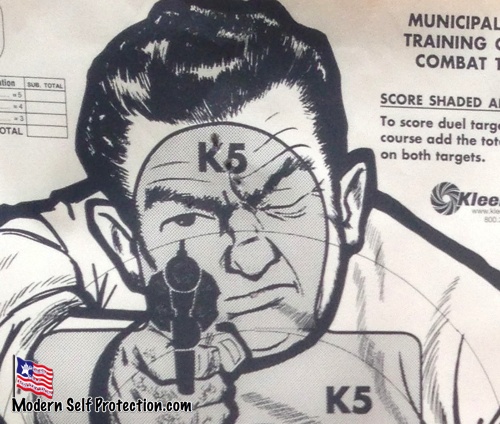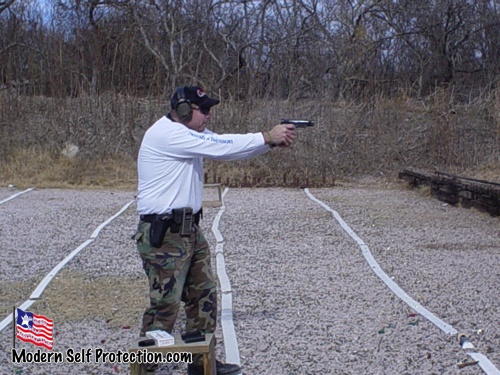Everyone wants to shoot better. I haven’t met anyone that hasn’t yet. So if you are reading this, shooting tighter groups is probably always on your to-do list. Here are some great tricks, tweaks, and hacks that will make you shoot tighter groups.
I use groups to make precision shots and to help me shoot long distance for self defense. I’m not a bull’s eye competitor, I use shooting groups as a tool to make me a better self defense shooter. You can use these tricks to make yourself more accurate in whatever you do.
Guns and Ammo:
Don’t worry about what gun or ammo you are using. Use whatever you want to get better with. Don’t use your race gun and expect to get better with your J-Frame revolver for self defense.
If you want to get better with your self defense gun, use the gun you carry the most. If you want to get better at IDPA, use the gun you shoot IDPA with. Just use the gun you want to be better with.
Don’t worry about what ammo you use. It won’t matter for a long time. If you shoot these drills and work this dry fire, it will be a while until you need to worry about the ammo, even if you consider yourself an expert.
Modern guns and ammo are so good these days they will out shoot you for a long time. In fact, they will out shoot 99.9% of the people that consider themselves shooters, that includes me. But I’m working on it and hope you are, too.
Everything always comes back to the basics and how well you can do them. The 7 fundamentals of shooting (this assumes that you know some of the basics):
Grip – When it comes to handgun just make sure you are holding onto it. I like a thumbs-forward, or high-thumbs grip. The grip is just to hold the handgun so you can press the trigger when it comes to accuracy. Don’t fight the recoil. Hold the gun just tight enough so it functions. The tighter you hold the gun the harder it is to just move the trigger finger without any of your other fingers doing anything.
Stance – One word, whatever. I don’t worry about the stance other than to make sure I have a natural point of aim. Your body will point in a direction on its own when you place your feet. To find your NPA (natural point of aim), stand facing a target, raise your gun towards it, align your sights, then close your eyes. Take a couple breaths and then open your eyes. Where your gun is pointing is your natural point of aim. Move your feet or at least your hips to fix where you are pointing. If you muscle the gun by just moving your hands, the gun will go towards your natural point of aim under recoil and you will never be as good as you could be.
Sight Alignment – Make sure you are centering the front post in the rear notch and aligning the top of the front sight with the back. Don’t use the dots, it’s too hard to see those and make fine adjustments. Focus on the front sight!
Sight Picture – Put the top tip of the front sight where you want the bullet to go. For these drills, put the front sight on the bottom of your aiming point. Again, most importantly, focus on the front sight!
Breath Control – With a handgun, just stop breathing. I like to breathe in then breathe half out. The most important thing, don’t breathe while shooting.
Trigger Control – This is everything with a handgun. Press the trigger straight back increasing pressure a little at a time. If the sights move, stop pressing but hold what you got. When the sights settle, start pressing again. Your trigger press needs to become perfect and you need to be able to do it without thinking about it because you are focusing on the front sight.
Follow Through – This is the one we screw up the most when shooting paper. As soon as the shot breaks we want to see where we hit. But the problem is that we think faster than the gun operates. We are looking for where it hit before the bullet has left the barrel. To look, we have to lower the gun so we start hitting low. Follow through, let the gun recoil and come back on target and see that front sight again, then lower the gun to see where you hit.
Dry Fire Practice:
Start with dry practice. It’s cheap and easy. Remember to be safe and get all and any ammo away from you and then triple check to make sure you don’t have any ammo. Then, if possible, dry fire at something that will stop a bullet if you mess everything else up.
Dry fire is where you are going to perfect your trigger pull because you can see if it’s right or wrong.
Start with an all white background. You don’t need an aiming point. Raise the gun and focus on the front sight and then press the trigger. When the gun clicked did the front sight move at all? If it did, then you need to work until it doesn’t.
Make that gun click without the front site moving before doing anything else. It could take a couple sessions and about 15 minutes per session is what to shoot for. Any longer and you start to get tired and then you will get worse, not better. Also, try to do 3-5 trigger pulls and then lower the gun and give your arms and eyes a rest. Then go back to it.
I generally shoot both eyes open, but it helps me to focus on the front sight if I close my non-shooting eye.
If it isn’t working for you, try putting your trigger finger in different places on the trigger. Remember to grip the gun lightly.
If you still feel like it’s impossible, put down the gun and work on just moving your trigger finger. Curl your other fingers back so they almost touch your palm and then work on moving only trigger figure back and forth. It will take practice and disciple to only move your trigger finger. But work on it, you’ll get it.
Once you get the front sight to stay still against a white background, now go to an aiming point and start again.
When you have that down, now you are ready to head to the range.
At the Range:
You have to do the same things you did in dry fire. You need to focus completely on that front sight and press the trigger the same way. Everything will come down to your trigger press.
Start ridiculously close, like 3 yards. Create an aiming point that works for you. If it’s too big you won’t be able to be precise, if it’s too small you won’t be able to see it. I like a circle that is a little bigger than my front sight when I’m looking at it down range. Bring a sharpie and you can make your own points, and then you can reuse your target for an entire session.
When you start shooting, the point isn’t to put a hole in the aiming point, it’s to get all of your shots touching. It doesn’t matter where they are on the paper. If they are all touching you are doing things correctly and moving the rounds to your aiming point will come later.
When you shoot, put everything into each shot. Only do 3 to 5 round groups for each aiming point and rest between groups. Rest your eyes and your arms by putting the gun down and focusing on something else. Just let some time pass.
When you can consistently (like 5 groups in a row) make all the rounds touch in a group (different groups not one big group), then move the target back one yard and start again.
Conclusion:
Don’t worry about the ammo or gun selection. It won’t matter until you get past 10 yards.
If you start skipping and move the target too far away, you will just get pissed off because you can’t make the hits. Start close, start slow, and it will come with time and practice. This isn’t a one-session deal. It will take you a lot of work to get really good.
If you consistently work at this, it will make you a much better shooter.
Anytime you want to get better at hitting little things way out there, or make your groups tighten up at the range come back to this drill and it will improve your shooting.
Stay Safe,
Ben


This is what I need !! Thanks Ben.
Great info. Can’t wait to try this.
Thanks Daniel, let me know how it works for you. It can be boring to shoot so close, but stick with it.
Will do